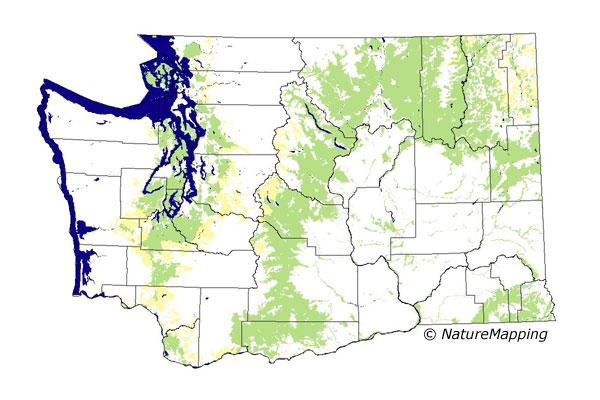 |
Metadata (Data about data or how the map was made)
Legend:
 = Core Habitat
= Core Habitat
 = Marginal Habitat
= Marginal Habitat
Predicted Distribution
Reptiles do not migrate as some birds and mammals, so the colored areas depict the predicted range for the Western Terrestrial Garter Snake
year-round. The habitats were identified using 1991 satellite imagery, other datasets and experts throughout the state, as part of the Washington Gap Analysis
Project.
Other
maps & Information:
|
Distribution and Habitat Requirements
Thamnophis elegans depends heavily on amphibians that breed in permanent and ephemeral waters such as lakes, ponds, shallow meadow pools
and stream pools for prey in the Sierra Nevada, but the preferred prey on Vancouver Island were slugs, fish and small mammals. Amphibians and
small mammals are known prey for Washington populations. This species is common near water in eastern Washington and largely absent in most areas
in western Washington, but locally abundant around edges of small lakes and ponds.
Models
All ecoregions were selected except the Outer Olympic Peninsula and Northwest Cascades.
West of the Cascades, the Woodland/Prairie Mosaic, Cowlitz River, Willamette Valley and Puget Sound Douglas-fir zones were core. In the forest zones
east of the Cascades, Oak, Ponderosa Pine, Interior Douglas-fir, Grand Fir and Low and High Elevation Lava Flows zones were core. Western Hemlock,
Interior Western Hemlock, Interior Redcedar and Olympic Douglas-fir zones were marginal. All steppe zones were core.
Good habitats were lakes, riparian areas (areas along rivers and streams) and all developmental stages of open-canopy forests except in Western
Hemlock, Interior Western Hemlock, Interior Redcedar and Olympic Douglas-fir zones where forests were excluded and grasslands, shrublands, shrub
and tree savannas were included. In addition, all forests in the steppe zones were good.
Model Evaluation and Comments
The model was based on inferences about macrohabitat association derived from the distribution of location data more than it was
based on microhabitat
association (i.e. water bodies). Records for this species indicate that the necessary water bodies can be quite small. At
the macrohabitat scale,
records were virtually absent from dense, wet conifer forest zones, thus it was inferred that closed conifer forest is probably
unsuitable. In steppe
zones, records were usually associated with riparian areas. It was assumed that brushy openings in hardwood and mixed forests
in wet conifer forest
zones, open-canopy conifer forests in relatively dry forest zones and any forest or thicket in steppe were appropriate.
Translated from the Washington Gap Analysis Amphibians and Reptiles Volume by Karen Dvornich
Webpage designed by Dave Lester.